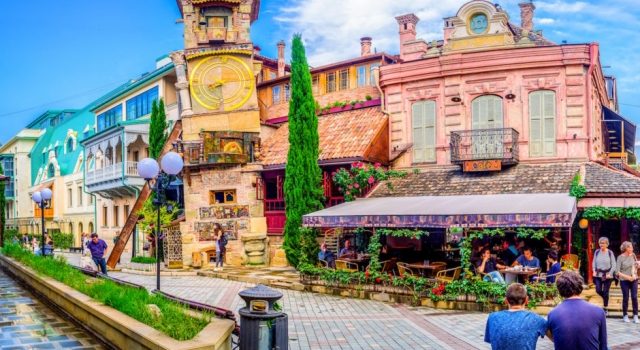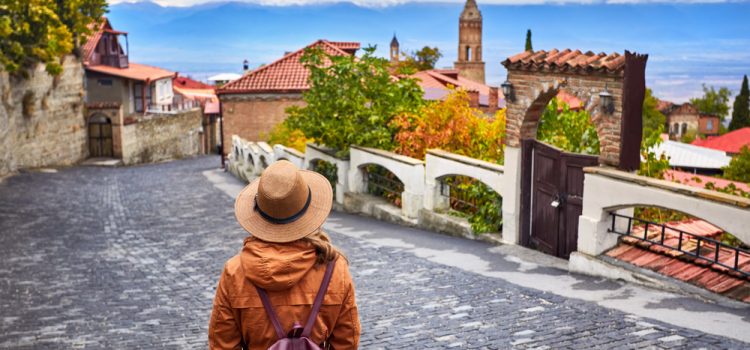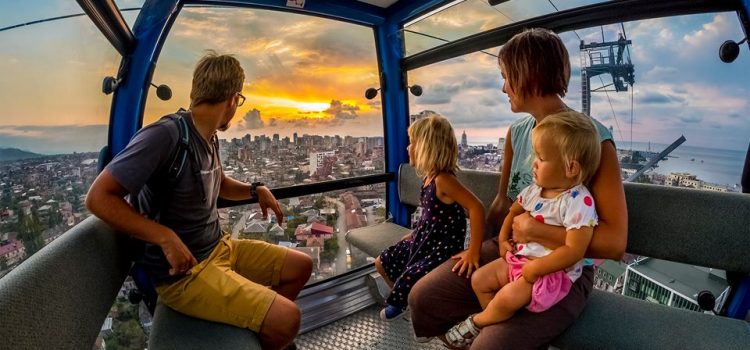tbilisi, possibly the coolest city in the world
When it comes to Tbilisi it’s safe to say the secret’s out. The capital of Georgia has been charming worldwide travellers with its alternative arts scene, world-class clubs and unforgettable cuisine for a while now – and it’s undoubtedly becoming one of the trendiest cities in Europe.
It’s a city of two halves; the Old Town is cluttered with antique stores selling Soviet-era war medals while younger, trendier areas are known for their lively bars filled with locals toasting firewater with strangers. The city feels familiar yet alien all at once, and it’s hard not be overcome by the welcoming Georgian lifestyle.
Georgia’s art scene, fashion and nightlife are behind the influx of traffic. If you’ve been to Berlin then you’ll recognise Tbilisi. They have distinctive similarities but Tbilisi feels effortless. Maybe the city manifests what Berlin was… once upon a time?
Like Berlin, raving is central to younger Georgians’ identity with techno music being the soundtrack to those seeking social liberty and cultural freedom. The underground club Bassiani is a concrete Mecca for techno; the main dance floor is a disused swimming pool and at weekends it’s flooded with smokey, Chacha fuelled clubbers dancing to promising Georgian DJs. Bassiani has sparked the question – could Tbilisi be the new Berlin?
With the rapid increase in tourism, we recommend jumping on Georgia now. Flights may be a little higher than you would like BUT it’s seriously worth it. Tbilisi is everything you need in a city break: be it a romantic getaway or a wild weekend with your pals. This rough-cut Caucasus gem will leave you wanting to pack your bags and relocate… if only we could speak the language!
Need help planning a to-do list? Here’s our list of the essentials things to do in our new favourite city.
source: www.mtv.co.uk
Georgia’s Historic Gem: Sighnaghi, The City of Love
Sighnaghi is a charming little town to the east of Tbilisi, located at an altitude of 740 meters above sea level. The town offers scenic views of the Alazani Valley and the Great Caucasian ridge, but not only this: Sighnaghi and its surroundings are being developed rapidly with more and more attractions popping up by the year.
When I first went to Sighnaghi in 2010, the town was already in the process of being restored. But even back then, a visit to Sighnaghi was a great experience in itself, taking into account its great historic wall, Sighnaghi National Museum, which houses a number of great masterpieces of Niko Pirosmani, and the town’s location close to the famous pilgrims’ destination, the Bodbe Monastery.
In 2010, Sighnaghi, in terms of infrastructure, didn’t have much to offer visitors aside from its great panoramic views and a few newly refurbished central streets. It had a few restaurants, one hotel and a couple of guesthouses. The rest of the town, with its crumbling facades, rusty roofs and pot-holed roads, reminded one heavily of a Potemkin village.
Since then, many things have changed. The city’s appearance, its roads, facades, and infrastructure have been restored or renovated; and throughout the town numerous restaurants and guesthouses have been established. Tourists from all over the world, including China, South Korea and Japan, now stream to Sighnaghi, meaning you’ll be hard put to find a household there which is not somehow involved in the tourism business.
“When I registered my guesthouse in the Booking.com system three years ago, I was the 34th on the list of Sighnaghi accomodation,” said Roman Beghashvili, a Sighnaghi guesthouse owner. “Now, there are around 150 on the list.”
Competition drives those in tourism to make their places more attractive to tourists. The ideas vary and are sometimes rather eccentric. There are plenty of picturesque cafés and hotels built beside the historic Sighnaghi wall. One of them, for instance, located on high stilts, seems to be hovering over the town, and offers guests the chance to take a paraglider flight or enjoy a drink overlooking the Alazani Valley and the historic wall, which is more than 4 km long. I’ve only had one comparable view of a medieval wall, and that was in the historic city of Avila in Spain.
“The first reminiscences of our town wall were found in chronicles of the 13th century,” said Mariam Guliashvili, the town historian. “But the construction of the wall which you can see now was ordered in the 18th century by King Irakli II. Our enemies used to attack our villages in the Alazani Valley: from the north came the Lezgins, from the south the Persians. They stole our women, children and livestock in order to sell them into slavery. To protect the inhabitants of the valley from the intruders, King Irakli II gave the order to construct this wall, which according to different documents was between 5 and 7 km long and had 23 towers and eight gates. Now we have over 4.5 km of it left, which comes close to the Small Wall of China with its 5 km length.”
Sighnaghi received its “city” status in 1770. At that time, it was already a vivid town of workmanship and trade with a population of up to 10,000 people, the majority being of Armenian origin. The King had ordered the Armenians to settle in Sighnaghi, as the Alazani Valley had previously been devastated by Shah Abbas, who took 100,000 Georgians to Persia.
In the following centuries, Sighnaghi became a great cultural and educational center, with its own theater and schools. Girls were educated in private schools established in the houses of rich citizens. In Soviet times, Sighnaghi was a flourishing tourist attraction with a big hotel located close to the town. The town was proud of its own Ethnographic Park, where archeologists from all over the country worked together on excavations. You still can visit this area now, if you take a walk in the beautiful and newly restored town park, which is romantically located on the slopes of Sighnaghi, behind the wall. Also worth a visit is the local cemetery, bearing many exciting stories of past times. With a little imagination, you can see the town history right there.
In order to inquire about recent tendencies in tourism, I headed to the Sighnaghi Information Center. The officer, Zurab Siprashvili, told me that just 10% of those who come to Sighnaghi actually visit the Information Center. He put the number of tourists that visited Sighnaghi last year at around 11,000 people, with the trend growing by the year. Most of the tourists come from Russia, Poland, Germany, France and Israel.
Sighnaghi’s location on a hill high above the ancient winemaking valley contributes to its increasing popularity. There are four big wineries as well as many wine degustation points in Sighnaghi.
From the town’s Deputy Mayor, Madonna Batiashvili, I learned about further plans concerning tourism and further development of the Sighnaghi region. “In future, we want our guests to stay longer in our region, so we plan to develop the nearby villages of Tsnori and Machkhaani. The latter is a unique village with an old theater from the 19th century and many historic houses, which are quite different from the usual Kakhetian houses. Machkhaani will soon be given the status of a Museum Village,” Batiashvili noted.
The town council plans to establish a new tourist route connecting Sighnaghi, Tsnori, Machkhaani and proceeding to Dedoplitskharo, a city with its own Pirosmani museum. Investments should be made in agricultural tourism for those visitors who enjoy nature, hunting and fishing, and who want to learn more about making churchkhela and baking Georgian bread. Several cable car routes should be established in order to connect some villages and allow visitors to enjoy great views of the Alazani Valley.
What else makes Sighnaghi so attractive for tourists? One of the town’s most renowned attractions is a quick marriage in the Marriage House, which operates 24/7.
“All you need is your passport and two witnesses,” Batiashvili told us. “Just imagine: I recently met a couple who became husband and wife early in the morning, at 4 am!”
Indeed, getting married is easy in Sighnaghi, as you don’t need to deal with bureaucracy at all. “Many of our citizens have become witnesses already, and they are now treated as relatives by the families of the newly married couples,” Batiashvili proudly said.
Source: www.Georgiatoday.ge; By Tatiana Montik
Why Tbilisi’s One of My Favorite Cities in the World
THERE ARE CITIES that make sense. The streets glide along straight, clean lines, their names uniform from start to finish. Bridges are crossable. Signs point in the proper direction.
Then there’s Tbilisi.
Riotous and anarchic, the capital of Georgia is anything but organized. Locals use Soviet-era street names—Leselidze, Davitashvili, Perovskaya—found only on decades-old maps. Wine is sold in repurposed Coca-Cola bottles for a dollar a liter from boulevard underpasses. The electricity still cuts out in the heart of the “Kala,” Tbilisi’s historic old town.
Despite this—maybe even because of it—this city is one of the best, most strikingly original travel destinations in Europe or Asia, if not the world.
Pop into an unmarked courtyard near the Armenian Norashen Church—overgrown with ripe pomegranates—and find yourself among well-fed stray cats in a bohemian artist’s studio (one of the workers may invite you for home-brewed, noxiously alcoholic chacha; he will not let you refuse, nor should you wish to).
Sneak into the basement of the red-brick seminary across from Sioni Cathedral and buy Tbilisi’s best bread—dough thrown against the scalding sides of a circular tone oven—from an elderly kerchief-wearing woman for 30 cents a loaf.
Head up a slanting set of town house stairs in the fin de siècle neighborhood of Sololaki and find yourself in a speakeasy-style apartment café called Linville, where tables hide behind vines on wrought iron balconies and afternoon tango milongas take place under decorative Victorian parasols.
Slip across the Dry Bridge, past the ruined frescoes of the former Grand Hotel, to the flea market and bargain with bearded ex-professors for wooden icons, Soviet-era gas masks, and Turkish tea glasses. Come more than once and the vendors will remember you (I buy my jewelry—traditional Georgian enameling—from the same seller every year; she recalls not just my taste, but that of the mother and grandmother I purchased gifts for).
The cliché, of course, is that Tbilisi represents the epitome of East meets West: a Silk Road crossroads where Arab, Ottoman, Mongol, and Russian imperial forces each left their own distinctive cultural mark. And in the heart of the old town, where rugs dangle from whitewashed wooden balconies and bearded Georgian Orthodox priests jostle with tourists on narrow cobblestone streets, it’s a compelling fantasy.
But the city’s reality is far more complicated—and intoxicating.
“East” and “West” are all but meaningless terms here, where the ancient fortress lording over old town has been used both by and against each set of conquerors, where the horizon—and the snowcapped Caucasus beyond—is punctuated by smoky Soviet tower blocks.
On Grishashvili Street, near the sulfur bathhouses—traditionally staffed not by ethnic Georgians, the by-far majority in this famously tolerant city, but by Muslim Azeris—a half-hidden chaikhana, or teahouse, serves baklava at carpeted banquettes before an open fire. A five-minute walk along the Kura River leads to Tartine—a French brasserie popular with expats and well-heeled locals alike—and café au lait delivered in gargantuan bowls. And at KGB, a restaurant whose tagline is “We’re still watching you,” Soviet kitsch takes on a hipster vibe.
Not all locals are as gleefully tongue-in-cheek about their city’s past, however. Shopping at the bazroba (bazaar), or feasting on caraway-spiced khinkali meat dumplings in wood-paneled working men’s taverns, you’re as likely as not to be dragooned into someone’s rhapsodic ode—in a mixture of Russian, Georgian, English, and fervently expressive gesturing—to the beauty of the mountains, the Virgin Mary, Mother Georgia, the tradition of hospitality, or women who happen to be in the vicinity.
Still, if Tbilisi has an aesthetic, it’s “retro collage.” Hidden bars like O Moda Moda—which doubles as a vintage clothing atelier—offer mulled wine and cocktails alongside traditional tarragon lemonade and syrupy Lagidze nectars served from massive soda fountains. Tbilisi’s most iconic eatery, Purpur, is a collection of mismatched tablecloths, 19th-century lamp shades, and crumbling flea market bric-a-brac.
But few places capture Tbilisi’s energy like the city’s hottest new restaurant, Café Littéra—brainchild of new celebrity chef Tekuna Gachechiladze—located in the palatial mansion that once housed the Soviet Writers’ Union. The food—chakapuli stew made with mussels instead of the traditional lamb, pomegranate-dusted river trout served a la tartare, classic badzhe sauce made, all but blasphemously, with almonds instead of the customary walnuts—reflects the best of Tbilisi’s breathless fusion culture.
Sure, the electricity might still go out at times.
But Georgians will light candles, shrug, and pour you another drink.
source: Nationalgeographic.com, by Tara Isabella Burton – regular contributor to National Geographic Traveler.



